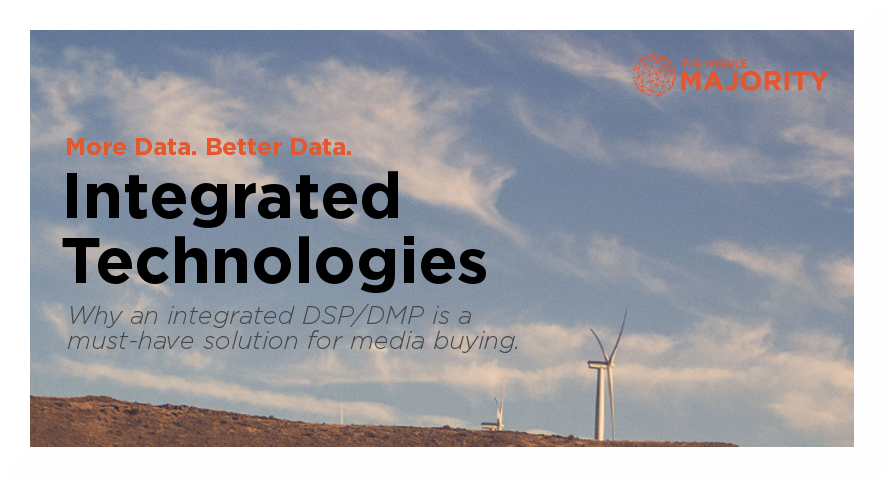If you’re a media buyer, you’ve likely started using a Demand Side Platform (DSP) to help automate the mobile ad buying process. And if you have, kudos! This means you’re well on your way to producing powerful, effective mobile advertising campaigns.
But what if I told you that your DSP isn’t working as effectively as those of your competitors?
Truth be told, using a DSP is just one part of creating highly successful mobile advertising campaigns. While the technology is important in and of itself, a DSP also needs a bit of help from another piece of integral software to be the best it can be.
This crucial piece of software is called a Data Management Platform (DMP). And if you haven’t yet added a DMP to your mobile ad tech arsenal, you’re already behind the competition, as many brands have been integrating DMPs with DSPs for some time now.
But I do have some good news: If you begin using a data management platform now, you can gain back major opportunities you may have missed when it comes to reaching your target audience on mobile.
But what are the differences between DSPs and DMPs, and how do they integrate to offer the best results and ROI for mobile ad campaigns?
Discerning the Difference Between a DSP and a DMP
What is a DSP?
A mobile DSP is a centralized technology platform that uses data to automate ad buying across a variety of publisher sites. The platform also connects advertisers (or advertising agencies) to the right customers for your brand through audience targeting. DSPs can sort through publisher inventory by each publisher’s unique parameters. In addition to ad buying, DSPs also deliver and track ads.
To put it in even more basic terms, a DSP makes the searching and sorting of audience segments and inventory type easier and more affordable due to the automated nature of the technology.
What is a DMP?
A mobile DMP is a centralized hub designed to gather all sorts of mobile data. A DMP provides an in-depth look at the consumer; from their purchasing behaviors, to what websites they visit and more.
Simply put, a mobile DMP is software that takes on the role of a mobile consumer data warehouse that sorts and houses detailed customer information, then ships it off to publishers, marketers and businesses.
So, DMPs and DSPs sound pretty similar.
While the line between the definitions of DMPs and DSPs may seem a little blurry, both are needed in order to produce the most effective mobile ad campaigns. While a DMP is used to store and analyze data, a DSP acts as a buyer for advertising based on the consumer information that DMPs offer. The information collected by a DMP is transferred to its DSP which helps with ad buying decisions.
Basically, without an integrated DSP, a DMP just doesn’t work as effectively standing on its own.
Why Thinking DMP-First is Crucial to Your Mobile Ad Campaign
A DMP Helps You Reach More Relevant Customers
Behaviorally-targeted advertising is much more effective than non-targeted advertising, and a DMP will work in tandem with your DSP throughout the automated ad buying process. As it locates relevant user data, a DMP will then tie together the user activity and audience data in a centralized location to help optimize future ad buys and ad creative.
A DMP Will Help Address User Identities Now and in the Future
As a DMP and DSP work together to access the best ad buys, creative, and audience targeting, a DMP will consolidate both first and third party data from various channels to make crucial connections between the information offered.
Once the best user identities for your brand are accessed, a DMP can sync these IDs to look at the behaviors, actions and responses tied to individual consumers, providing complete data sets for audience creation and optimization for both current and future use.
A DMP Offers Something for Everyone
So, who uses DMPs? Ad agencies, publishers and marketers can all benefit from integrating DMPs with DSPs. For example, advertising agencies can use DMP technology for both data and analysis for multiple client campaigns. Publishers can also use DMP technology to better understand reader information and derive more value based upon the data collected.
As a growing number of brands are finding that DMPs make audience data more portable and easier to integrate with DSPs, they’re miles ahead of the companies who are using DSPs only. In order to help brands fly past the competition toward unprecedented audience targeting precision, the Mobile Majority has built our own mobile data management platform that leverages millions of data profiles from consumers all over the country.
And — you guessed it — our DMP integrates with our mobile demand-side platform to ensure your brand is reaching more customers who are relevant to your company’s success.
Now, all you have to do is take the leap.

